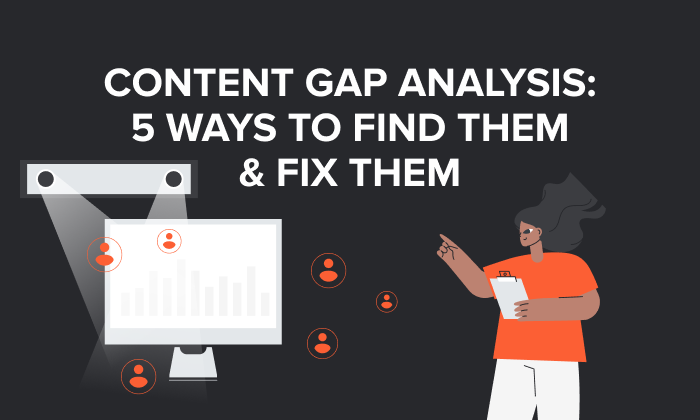
When it comes to content creation, gaps are inevitable. You can be the best writer out there, but that doesn’t stop the world from continuously evolving.
Information becomes outdated.
Keywords fluctuate over time.
Customers shift interests.
It’s not your fault. But if you want to stay ahead of the game, it IS your responsibility to find and fix any content gaps that arise.
Why are content gaps a big deal?
Content gaps are basically missed opportunities. When customers can’t find what they’re looking for on your page, you can bet their next step will be in the direction of your competition.
The trick is learning how to identify content gaps and knowing what to do when you find them.
What Are Content Gaps?
Content gaps are topics not currently on your website that your target audience is looking for.
Your audience is always on the lookout for new information. And with content gaps so common, you would think that companies would pay closer attention to them. However, a 2021 study shows that 46% of companies with unsuccessful content marketing strategies don’t analyze their content once it’s been published.
Your industry may have thousands of topics your target audience is searching for that you have yet to cover.
For example, say you’re an SEO agency that has dozens of blog posts on advanced SEO techniques. However, you notice readers are bouncing from your pages quickly and far too often.
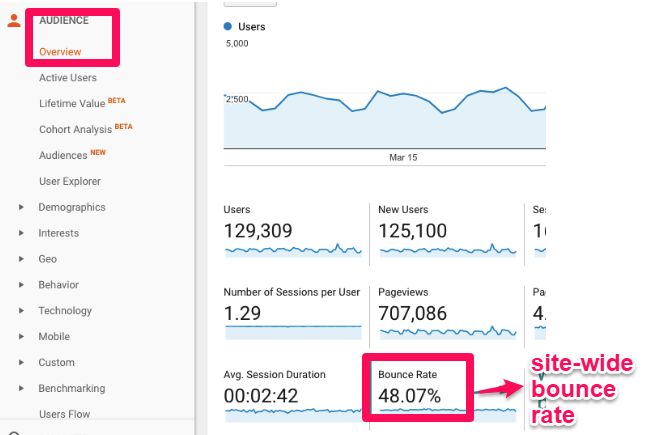
You might wonder if your content is engaging enough.
A quick content gap analysis can shed some light on the problem. Maybe your target readers are looking for basic SEO techniques while you only offer advanced information beyond their interest or ability to understand.
If you want to make sure your readers stay engaged, it’s important that the content they’re reading is current and useful for their needs.
Why Is It Important to Identify Content Gaps?
Content gap analysis sounds like a lot of work, but the results are worth the effort.
- Improved SEO: Eliminate content gaps to improve your site rank on search engines. Your placement on the search engine results pages (SERPs) matters because 88 percent of searchers only visit links on page 1 of search engines like Google.
- Better connect with your target readers: Fixing content gaps can give your readers exactly what they’re looking for, thus establishing a connection with your site. It’s important and possible to build a relationship with your audience— in a survey of 1,000 American participants, over 65 percent say they felt an emotional connection to a particular brand.
- An optimized buyer journey: Content gap
sanalysis reduces bounce rates and increases on-site time, which in turn will improve your conversion rate, resulting in more sales.
What Are the Different Kinds of Content Gaps?
In order to perform a content gaps analysis, you have to learn how to identify them in the first place. Content gaps generally take one of three forms: keywords, topics, and media.
Keyword Gaps
Not all keywords are created equal.
For instance, the click-through rate (CTR) for the top spot in Google for one-word search queries is 32.5 percent, which is higher than the CTR for long tail keywords. However, starting at position two, the CTR for long-tail keywords is actually higher than the CTR for one-word queries.
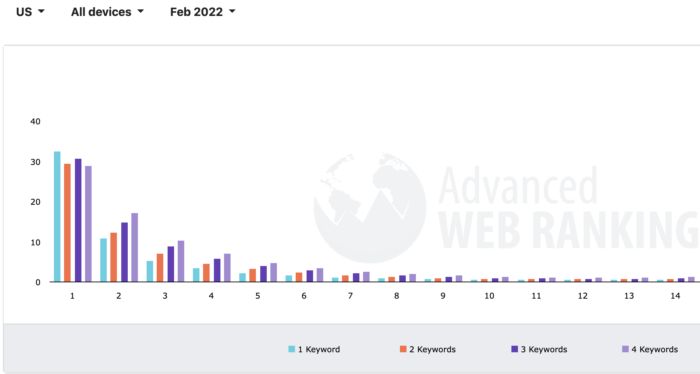
Long-tail keywords are so effective because they reach customers that are further along in the purchasing process. While 1-keyword searches tend to be used for information gathering about a topic, searches with 4 keywords or more are used, also known as long tailed keywords, when potential customers are honing in on the product or service they are looking to buy.
If you focus all your marketing resources on short, popular keywords, consider integrating these longer chains of keywords into your content.
The best part? While short keyword searches are highly competitive and lead to low conversion rates, long-tail keywords typically have less competition. So your website will likely rank higher than sites that only optimize their content for generic, overused target phrases. Less keyword competition means your content ranks higher in the SERPs and traffic to your website goes up.
Check out my free tool, Ubersuggest, for some extra help.
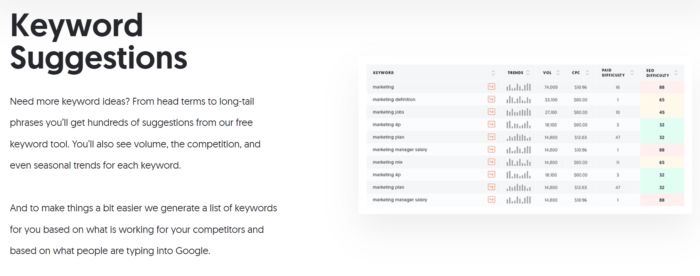
Topic Gaps
When people think of content gaps, topics are typically the first thing that comes to mind. Each time you run a content gap analysis on your topics, ask yourself the following questions:
- Does my site cover every topic readers are interested in?
- Does my site have comprehensive content for readers at all levels?
- Are the topics relevant to readers’ current interests?
If you answered “no” to any of those questions, congratulations: you have found a content gap!
Topic gaps are hidden opportunities to add brand-new content to your site. Whether you are diving deeper into a specific aspect of a broader subject you’ve already covered or you are solving new problems that have sprung up in your field, filling topic gaps is a fast way to provide new quality content to potential customers.
Media Gaps
Media gaps refer to a lack of video content on your website. If you have trouble finding time to make video content, you’re not alone. However, you are in a swiftly shrinking demographic.
A survey released in 2022 found that only 14% of businesses refrain from video marketing.
There’s a good reason businesses have shifted to video: it’s what their audiences crave.
Recent studies show nearly 75% of users prefer to learn about a product or service by watching a video instead of reading about it.
The benefits of adding media to your content should not be ignored. Increased brand awareness, higher website traffic, and more direct sales are all possible by simply converting your written content into a video format. In fact, 81% of marketing professionals surveyed say they increased their direct sales with the use of video content.
This is a huge wake-up call for all the content marketing teams out there to find media gaps in their content and fix them by adding videos to their posts.
5 Methods for Finding Content Gaps
You’ve learned what content gaps are, why they’re important, and what you should be looking for.
Now let’s look at how to find and fix them using content gap analysis.
1. Run a Content Gap Analysis Using an SEO Tool Like Ubersuggest
If you’re worried about spending hours poring through data, manually analyzing every piece of content you’ve ever posted, I have some good news for you.
Free and paid online tools like Ubersuggest will do this job for you.
Ubersuggest offers a number of features that let you dig into your website’s data to quickly find problem areas.
Use it to generate reports for keywords, browse top-performing content and even analyze your competitor’s site.
The process for using my tool is simple.
- First, visit the Ubersuggest homepage.
- Next, enter the domain name or keyword you want a report on.
- Click “View all” or select the appropriate filters at the top of the report.
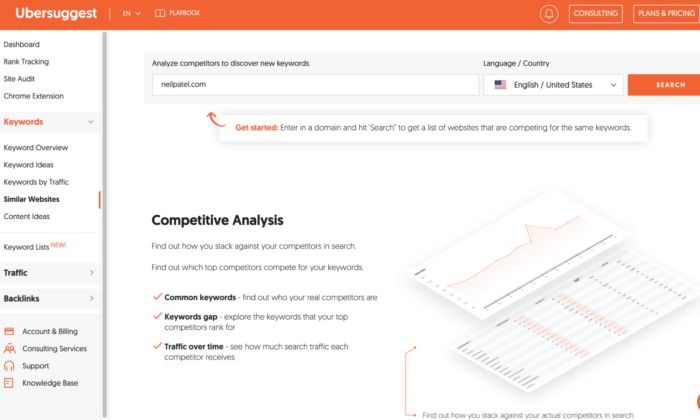
- Finally, click Export at the top of the report to store the information elsewhere.
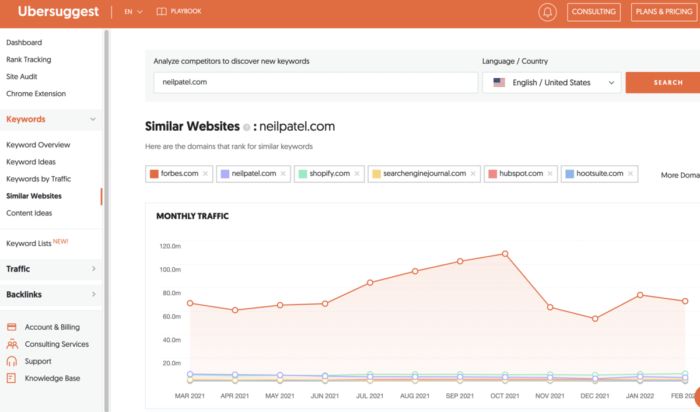
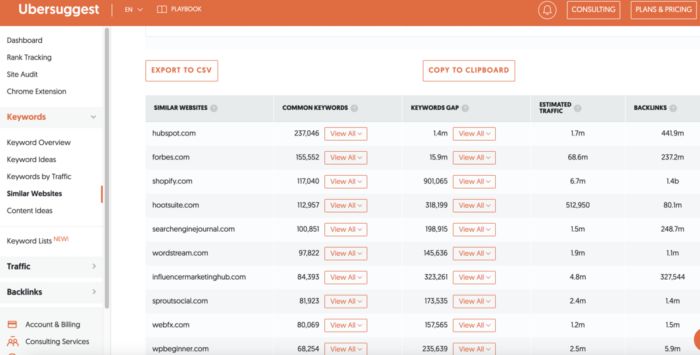
How to Fix Keyword Content Gaps
Once you have found stronger keywords for your posts, you can fill the content gaps in several ways.
Include the new keywords in your upcoming content. Don’t just sprinkle them haphazardly. Instead, incorporate keywords organically, in ways that increase the quality of your content.
Update old content with missing keywords. This often entails reworking sentences and even whole sections in order to maintain quality content for your audience.
As a preventative measure, you may want to alter your current keyword optimization strategy as well. Make a habit out of searching for keyword content gaps in your articles to remain at the top of the search results in your field.
2. Audit Your Customer Journey and Identify Content Missing from the Funnel
Not all content gaps are as easy to fix as keyword content gaps. The trick here is to dive deeper into your customer journey to figure out what your target readers need at each stage of their buying process.
Not every customer visits your website ready to make a purchase. Some are just curious, while others are comparing your products with the competition.
For the best results, you want to create content for each of these stages.
You need posts that make users aware of your products and services. You also need posts that provide valuable industry insights that address customer pain points and solve problems.
Even USA.gov took this approach to figure out what content they were missing. With the help of a specific customer audit process called journey mapping, USA.gov created detailed customer personas which were given behavior lines similar to their actual customers. From there, they were able to identify problem areas, confusing web pages, customer pain points and more.
Let’s use my site as an example. New website visitors wondering what my companies are all about can find everything they need to know with one click.

You’ll also need content for users to compare options between your product and the competition. This can be as simple (and powerful) as a “vs” article. You can offer comparison points for well-known competitors.
Buy Me a Coffee does this well with an attractive comparison page featuring their top competitor, Patreon. Notice how they highlight features that are exclusive to their brand.
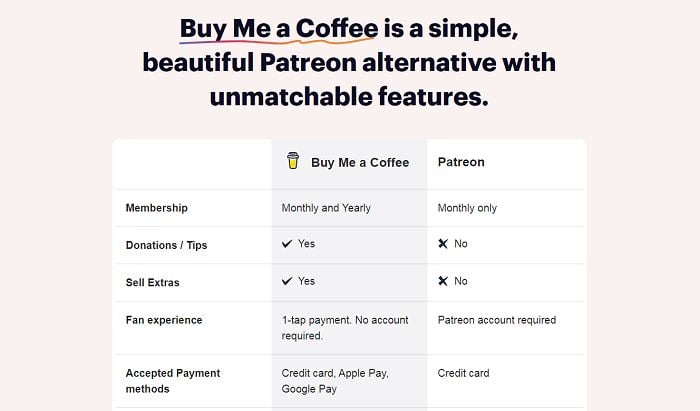
How to Fix Content Gaps
Content gaps are the easiest type of gap to find and fix. Once you’ve mapped your customer journey, you’ll have a better idea of which stages in the buying process you need to add to your existing content.
Create helpful tutorials and interesting industry articles. Write about the products and services you offer. Take what you have to offer and compare it to the competition.
3. Manually Search Competitor Websites to Identify Content Gaps
It’s not always clear what your content is missing. Thankfully you can always take a peek at what the competition is up to!
It can be hard to figure out what’s missing from your content on your own.
That’s where you can get help from the competition!
It’s quite simple.
Identify what your competitors are doing right and then replicate it. Remember, the goal isn’t to create an exact copy. Rather, your aim is to find keyword, topic, and content gaps that your competition fills.
You can do this manually by visiting competitor websites and noting what is missing from your own site.
For example, you may visit another SEO agency’s page and see they’re covering Google’s most recent algorithm update, but you haven’t yet.
How to Find and Fix Content Gaps Through Manual Competitor Research
- First, make a list of your top competitors. If you aren’t sure who they are, Google some of the most important keywords you target and see who else is ranking for them. You can also use SEO tools to help you find competitors.
- Next, visit each competitor’s page and make a list of topics your website is missing.
- Finally, brainstorm with your team about how to create a page on the same topic in a different or better way.
Be careful, though.
While competitors can provide inspiration for new content ideas, avoid copying exactly what they do. You want to look for new perspectives they failed to cover. A competitor may be getting great results with a particular keyword, but it doesn’t mean you should always create similar content. Think critically about whether what your competitor is doing is even applicable to your website and audience.
4. Use Google Search Console
Did you know you can use the Google Search Console to perform a content gap analysis?
I’ll show you how.
First, log into Search Console and click “Search Results” on the left side of the page.
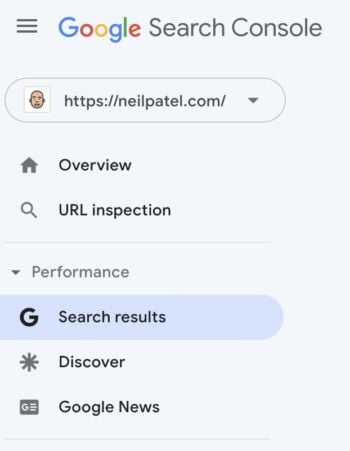
Next, click the “+ New” next to “Search type” and “Date range” (which you can modify).
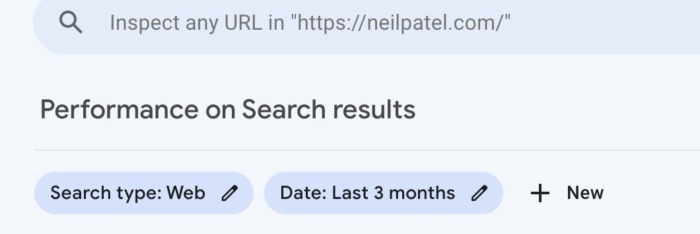
When the box pops up, click “Page.”
Enter the URLs for your top-performing pages, one at a time.
When the results populate, see what keywords you’re ranking for on that page.
Go to the page on your website or in your CMS and search for all of your top keywords from Search Console (either top clicks or impressions).
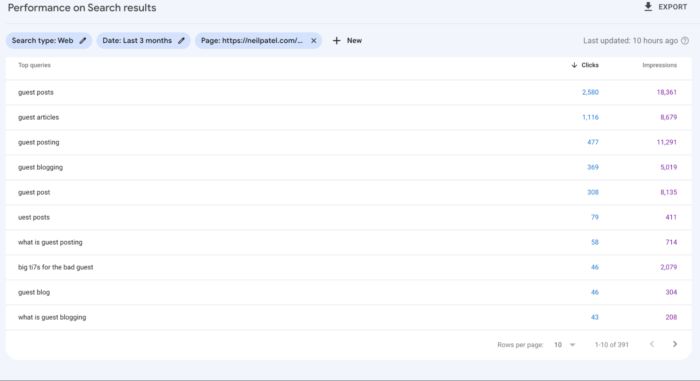
Finally, go to the post on your website and make sure the content is related to your top-performing keywords. Odds are, some of the keywords you rank for will not actually be covered on the page.
Once you identify the keywords you’re ranking for that are not covered on the page, create content that does by either creating a new post or adding a section to your existing one.
5. Perform a Self Content Audit
When was the last time you poked around your own website to find gaps in your content?
Using SEO tools and checking out the competition can be effective, but sometimes it’s easier to perform an audit on your own content instead.
Self content audits are a solid practice to perform on a regular basis, as it develops your eye for identifying gaps faster. This can help you find problem areas in your current approach and improve the creation process for future content.
Not only that, by running a content audit, you’ll occasionally discover broken links, outdated images, and even grammatical errors that can then also be fixed before they give visitors a negative experience.
For instance, you can start by updating old reviews on your page. Studies show 79 percent of consumers trust online reviews as much as they believe in personal recommendations, so updating outdated reviews can increase customer trust in your website.
An important thing to keep in mind here is that self content audits aren’t the type of thing that you only do once. A regular cadence is key here to keep your content fresh. How often you do it will vary based on how much content you have and your industry, but 6 months is a good starting point.
Content Gaps Frequently Asked Questions
Create content for new topics, update older content with more recent data and research the best keywords to use. Check the competition for other content gaps. Run a self content audit on your entire website.
Free and paid SEO tools like Ubersuggest can help find content gaps through competitor analysis, keyword research, and SEO audit features. You can also perform these functions manually with the help of offline tools like spreadsheets.
The keywords you use in your website or blog can make a world of difference when it comes to ranking higher on search engine result pages. Data shows that less than one percent of users visit the second page on Google, so it’s best to optimize your keywords to get on the first page.
Media gaps are the next most important gaps to fix. The need for video content will only increase. If you haven’t already, start transforming your written content into video.
Content gaps make it difficult to attract new readers, retain your current readers, and encourage them to convert. If your page has a lot of content gaps, your readers will move on to a competitor that fills the void. Having content gaps will diminish your authority in your space. Being up to date and relevant will instill trust within your readers that you are the industry expert.
Conclusion: Content Gaps
By utilizing SEO tools, like Ubersuggest, to find keyword and topic gaps in your content, your pages will see more traffic than ever before. Examine your keyword strategy with Google Search Console to figure out where you can close the gap.
Use content gap analysis on competitor pages or on your own site to discover what you can change.
Content gaps are secret opportunities that, when fixed, lead to valuable material that attracts new audiences and the potential revenue your business can earn.
Using these methods, you should be able to generate plenty of new content ideas and drive more traffic to your website.
Which method for filling content gaps are you going to try first? Let me know!
from Neil Patel https://ift.tt/tKZ1Y7j
via IFTTT
No comments:
Post a Comment